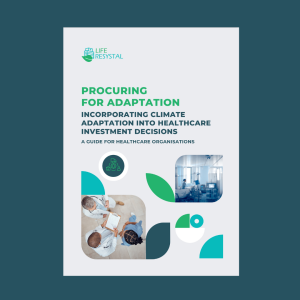
As climate change accelerates, extreme weather events such as heatwaves, storms, and droughts are placing unprecedented pressure on healthcare facilities, testing their ability to withstand and recover from climate-related disruptions. Procurement must play a pivotal role in strengthening the resilience of healthcare systems by prioritising the acquisition of sustainable, durable, and, most importantly, future-ready resources. The health sector is a major procurer of public goods and services and, as a result, has significant influence in the development of new climate-ready goods and services, not only for healthcare but for broader society. By incorporating both mitigation efforts to reduce emissions and supporting adaptation strategies to protect vulnerable and exposed hospital sites, procurement can serve as a powerful lever for climate action within the healthcare sector.
In response to this pressing need, the LIFE RESYSTAL project has developed two key publications designed to empower healthcare organisations to transform procurement practices into tools for climate resilience and sustainability. The two guides, Procuring for Adaptation: Incorporating Climate Adaptation into Healthcare Investment Decisions and Guidelines for Greener Procurement in Hospitals, outline actionable strategies for reimagining procurement as a direct pathway to enhancing the resilience and sustainability of healthcare systems. Discover their insights and recommendations below.
Procuring for Adaptation: Incorporating Climate Adaptation into Healthcare Investment Decisions

Developed by researchers at the University of Cambridge, the forward-looking Guide provides healthcare organisations with a clear framework for making procurement and investment decisions that prioritise climate adaptation. Targeted at hospital managers and procurement professionals, the guide emphasises how strategic investments can help facilities withstand the impacts of a warming planet, such as prolonged heatwaves or severe storms. Healthcare organisations may be interested in adaptation interventions such as retrofitting infrastructure to improve thermal performance, enhancing stormwater management systems, and upgrading energy systems to ensure continued power supply resilience during extreme conditions. By adopting these strategies, hospitals can not only protect their facilities but also safeguard the well-being of patients and staff during climate-induced disruptions.
At the heart of this guide are 12 principles to help decision-makers make investment and procurement decisions in ways which drive adaptation in the physical infrastructure of the facility. These principles can be applied to existing procurement processes and incorporated within sustainability strategies, to inform funding allocations and adaptation-focused interventions. The contents of the guide can inform not only investment decisions specifically trying to tackle climate adaptation directly, but they can also be used to incrementally steer the organisation towards more climate-ready procurement through day-to-day spending.
Guidelines for Greener Procurement in Hospitals
While the first guide focuses on how to approach procurement from a climate adaptation perspective, the Guidelines for Greener Procurement in Hospitals, developed by researchers at NCSRD (Demokritos), complement this effort by promoting green procurement (GP) practices that align with EU sustainability goals. The document provides an overview of the EU’s Green Public Procurement Standards, highlights the benefits of integrating environmental considerations into procurement processes, and offers practical examples of successful implementations across Europe.
The guidelines outline a high-level, phased approach to adopting green procurement practices, with a focus on areas such as energy, waste management, and sustainable gardening.
Bridging adaptation and sustainability
Procuring for Adaptation aids facilities in physically preparing for climate change and procuring to limit its impacts on healthcare facilities. Guidelines for Greener Procurement in Hospitals helps organisations choose products that align with the green procurement criteria. For instance, a hospital retrofitting its infrastructure for improved climate resilience can simultaneously adopt greener procurement practices for materials and services, achieving a dual benefit of adaptation and sustainability. Together, these two LIFE RESYSTAL project tools form a powerful toolkit for healthcare organisations.
Taking action
To get started, healthcare leaders can use Procuring for Adaptation to:
- Identify and prioritise adaptation investments
- Understand how adaptation is supported by the sustainable procurement environment and associated processes
- Make climate-informed spending decisions which take into account long-term costs/savings and the viability of different options
- Ensure that contracts are designed with the future in mind
They can also use Guidelines for Greener Procurement in Hospitals to align procurement processes with green criteria and to advocate for funding that supports sustainability initiatives.
By integrating these strategies, healthcare systems can lead the way in building climate-resilient and environmentally responsible operations, safeguarding their future in an increasingly unpredictable world.
Access the Procuring for Adaptation guide here and access the Guidelines for Greener Procurement in Hospitals here!